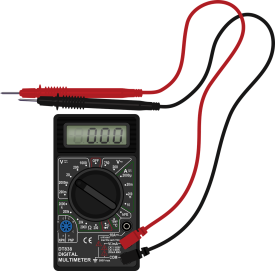Using a digital multimeter (DMM) allows you to measure voltage, current, and resistance in electrical circuits. Here's a general guide on how to use a digital multimeter:
Select the Correct Setting: Turn the dial on the multimeter to the appropriate setting for the type of measurement you want to make. For example, select "V" for voltage, "A" for current, and "Ω" for resistance.
Turn on the Multimeter: Press the power button to turn on the multimeter.
Set the Range: If your multimeter has manual range selection, set the range to an appropriate level for the expected measurement. For example, if you expect to measure 5 volts, set the range to 20 volts.
Connect the Probes: For voltage and resistance measurements, connect the red probe to the positive terminal and the black probe to the negative terminal. For current measurements, you may need to move the red probe to a different terminal labeled for current measurements.
Measure Voltage (DC): To measure DC voltage, touch the probes to the circuit or component you want to measure. The display will show the voltage reading.
Measure Voltage (AC): To measure AC voltage, set the multimeter to the AC voltage setting and follow the same procedure as for DC voltage measurement.
Measure Current: To measure current, make sure the circuit is disconnected and set the multimeter to the current measurement setting. Connect the multimeter in series with the circuit, with the current flowing through the multimeter. The multimeter will display the current reading.
Measure Resistance: To measure resistance, set the multimeter to the resistance measurement setting. Touch the probes to the two ends of the resistor or component you want to measure. The multimeter will display the resistance reading.
Turn Off the Multimeter: After you have finished using the multimeter, turn it off to conserve battery life.


